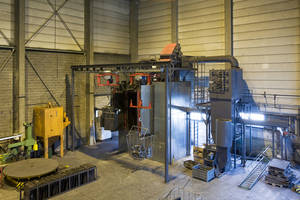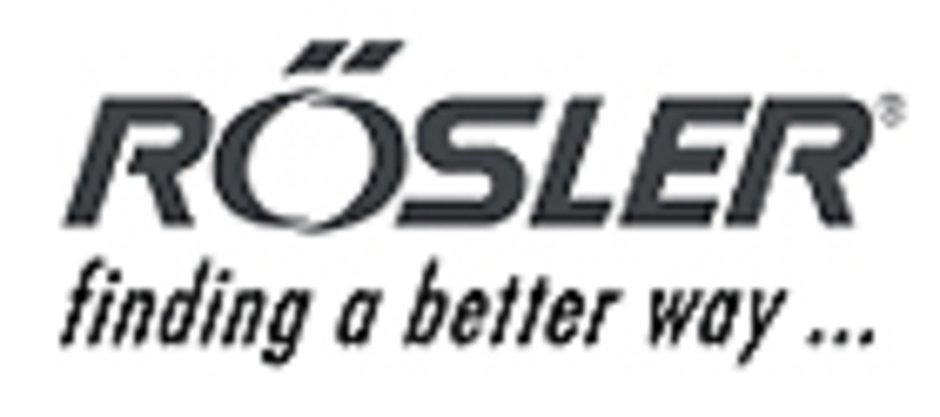Article also available in <link _top>
Higher production volumes and quality requirements prompted Doncasters Settas to invest in a new de-moulding shot blasting system. Rösler Oberflächentechnik fulfilled the customer specifications for shotblasting of very diverse, complicated titanium investment and precision sand castings with a tailor-made monorail blast system that was specially designed for this foundry application. The machine stands out due to its high flexibility, optimum wear protection, an effective blast media reclaiming system and a high sand removal rate. All these features helped to reduce the cost of de-moulding and extend the machine’s operating life.
Doncasters was founded in Sheffield, Great Britain, in 1778. Today the group has various subsidiaries operating at different sites in Great Britain, Continental Europe, the USA, China and Mexico. Doncasters is a leading manufacturer of precision components and assemblies for the aerospace industry, manufacturers of industrial gas turbines, the automotive industry (Formula 1 motor racing, among others) and the petrochemical market. The group has specialised in the processing of metals and alloys that are difficult to shape and form. This includes titanium and various types of titanium alloys. The Belgian subsidiary, Doncasters Settas S.A., operates a VAC melting furnace and uses centrifugal casting with centrispinning technology to produce high-quality precision sand and investment castings from these metals on a 3m (118 in) centrifugal table - the world’s biggest - such as, for instance, various aerospace components, gearbox housings and other critical parts for Formula 1 as well as complex titanium castings used in the petrochemical industry, in seawater desalination plants and general machine building. On the one hand, the customer benefits from the extraordinary mechanical properties (similar to those achieved in forging) realised with the Settas procedure, and on the other hand from the quality assured by the company’s numerous accreditations (ISO 9001, ISO 9100, Nadcap, ISO 14001, PED, ADWO, NORSOK M650R2).
Due to its Formula 1 activities Settas has also become an expert in rapid prototyping which allows it to develop complex prototype components at very short lead times. The titanium investment castings can weigh up to 120 kg (265 lbs). The titanium sand castings weigh up to 400 kg (882 lbs) each.
The use of shot blasting for de-moulding offers high quality at lower cost
The investment (lost wax) and precision sand castings produced by Doncasters Settas must meet extremely high quality and precision standards. The quality cannot be compromised by the de-moulding shot blast process. At the same time the shot blast process must be highly cost-effective. These requirements, as well as the demand for a higher production capacity, could not be met by the existing shot blasting machine, and Doncasters Settas was forced to invest in a new system. The company contacted various manufacturers in search of a solution, among others, also the Rösler branch in the Netherlands. “The new machine had to be capable of removing virtually 100 per cent of the entire moulding sand sticking onto the components with either thin or thick cross sections without damaging any of the castings, preferably in a shot blasting time that allowed for a high throughput rate. Furthermore, we wanted the new system to provide for a certain capacity reserve. Another crucial aspect was an effective media recovery system that helped to minimise our cost for wear parts”, explains Axel Luckow, Managing Director at Doncasters Settas, the requirements for the new shot blast equipment.
 <link file:7071> |
Optimally suited to meet the requirements of a sand foundry
The engineers of the Untermerzbach-based machine manufacturer prepared the concept and design of the overhead monorail de-moulding shot blast system, model RHBE 20/25. “Rösler’s solution really convinced us, as it not only provides high flexibility but is also more suitable for our requirements than the machines offered by the other companies”, said Axel Luckow when asked why the system offered by Rösler was chosen. The housing of the shot blast machine with dimensions of approximately 2600 x 3000 x 2680 mm [102 x 118 x 106 in] (WxHxL), is made entirely of wear-resistant manganese steel. The areas directly exposed to the blast stream are additionally protected by highly wear-resistant replaceable cast liners.
The shot blasting chamber is equipped with four high-performance blast wheels, type Hurricaneâ H 28 with a diameter of 280 mm [8 in] and an installed power of 15 kW each. The wheels are vertically mounted on the side wall of the blast chamber. 3D-animated simulations of the shot blasting process helped determine their optimum location and inclination angle. Each blast wheel can be driven individually via the PLC, which means that the blast wheels can be used in any combination desired.
Component-specific programmable blasting process
After the actual casting process a Y-shaped overhead monorail with two shuttle carriages transports the sand moulds, which may weigh up to three tons, into the shot blasting chamber in a “wire basket”. The system PLC contains various processing programs for the various castings, including blast time and blast intensity. Starting with the top wheel, the de-moulding process takes place with single wheels blasting certain defined areas on the castings with steel shot S 390. This process lasts about four to five minutes. Throughout the blast process the castings rotate in front of the blast wheels. This type of de-moulding can be compared to the “peeling of an apple”. On the one hand it prevents damage to the parts as the sand mould is removed in a controlled manner and, thus, prevents the titanium components from dropping within the wire basket. On the other hand blast media and sand are kept in the system at a fixed ratio which helps ensure an effective separation of media and sand. When the castings are 80 - 90 per cent free of sand, all four blast wheels will blast the components for five to ten minutes. This guarantees that any residual sand is safely removed from any cavities in the castings.
The sand dust generated during the shot blasting process is extracted continuously. This requires high airstream velocities which may “pull along with them” blast media. To recover the blast media the Rösler RHBE 20/25 is equipped with a dropout box.
Transport of the media/sand mix with encapsulated vibratory hopper with connection to the dust collector
The RHBE 20/25 shot blast machine supplied to Doncasters Settas is equipped with a fully enclosed low-wear vibratory conveyor to return the blast media/sand mixture. It contains a separation screen that automatically separates and discharges sand lumps, coarse dirt particles and gates & risers from the system.
The quartz dust generated during the process is exhausted at multiple points – vibratory conveyor and elevator – so that no dust can escape into the building. A dust collector with double filtration removes airborne dust particles and recirculates the cleaned air back into the environment.
Optimum media recovery minimises wear and operating costs
To ensure that the large amount of sand is reliably separated from the blast media, the overhead monorail shot blasting machine at Doncasters Settas is equipped with a dual drum magnetic separator. A thin film of the blast media/sand mixture is spread evenly across two broad magnetic drums. The strong magnetic force of the electromagnets located inside the drum separates the ferritic blast media from the sand. In addition, the double-cascade air wash separator removes microfine particles from the media. During the parts unloading/loading cycle the mixture is further cleaned by a bypass separator: A special valve located at the blast media storage hopper releases a certain quantity of blast media which is fed via the bucket elevator into the magnetic separator, then further on into the double-cascade air wash separator and back into the blast media hopper. This special media reclaim system guarantees that only a minute amount of sand remains in the blast media, thus reducing both wear and operating costs. An integrated back-feed system transports the removed sand to a sand reclaim system nearby.
Dust treatment without explosion protection
Usually, the treatment of blast media/dust mixtures generated when shot blasting titanium parts requires the same explosion protection measures as the processing of aluminium and magnesium parts. Rösler, however, conducted a dust analysis at Doncasters Settas which showed that the dust generated during the de-moulding shot blasting process is not explosive. The analysis saved the Belgian foundry additional investment costs.
Suppliers Catalogue: <link _top>Rösler Oberflächentechnik GmbH


